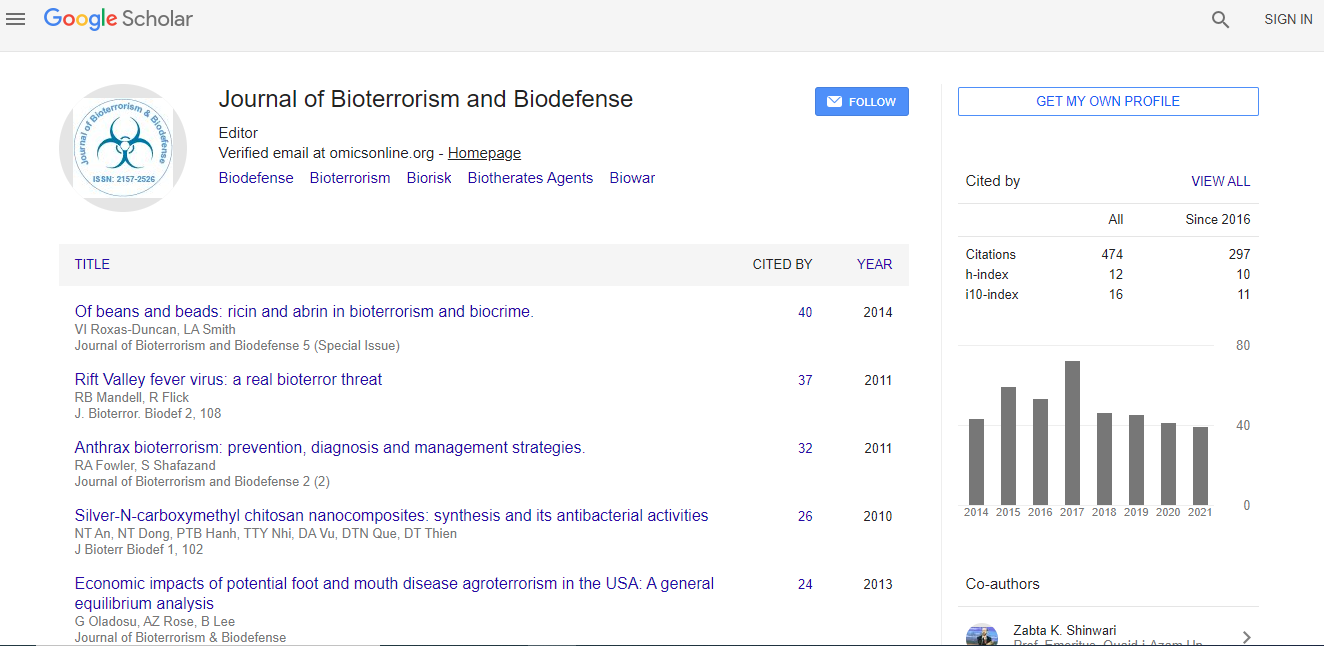Research Article
A Computational Analysis to Construct a Potential Post-Exposure Therapy against Pox Epidemic Using miRNAs in Silico
Mahmudul Hassan, Ewen McLean, and Omar Bagasra*
South Carolina Centre for Biotechnology, Department of Biology, Claflin University, Orangeburg, SC 29115, USA
- *Corresponding Author:
- Bagasra O
South Carolina Centre for Biotechnology
Department of Biology, Claflin University
Orangeburg, SC 29115, USA
Tel: 803- 535-5253
E-mail: obagasra@claflin.edu
Received Date: December 16, 2015; Accepted Date: February 15, 2016; Published Date: February 22, 2016
Citation: Hassan M, McLean E, Bagasra O (2016) A Computational Analysis to Construct a Potential Post-Exposure Therapy against Pox Epidemic Using miRNAs in Silico. J Bioterror Biodef 7: 140. doi: 10.4172/2157-2526.1000140
Copyright: © 2016 Hassan M, et al. This is an open-access article distributed under the terms of the Creative Commons Attribution License, which permits unrestricted use, distribution, and reproduction in any medium, provided the original author and source are credited.
Abstract
Background: Smallpox was caused by Variola Virus (VARV) and even though it was eradicated in 1979, there exists the possibility of a zoonotic epidemic from Ortho-pox that may be pathogenic to humans. Moreover, VARV may still be used as a bioterrorist weapon. Monkey Pox Virus (MPXV), which is closely related to smallpox, is endemic to certain parts of Africa where sporadic outbreaks in humans are reported. In 2003, an outbreak of human MPXV occurred in the US after the importation of infected African rodents. Since the eradication of smallpox caused by an Ortho Pox Virus (OPXV) related to MPXV, and cessation of routine smallpox vaccination with the live Vaccinia Virus (VACV), there is an increasing population of people susceptible to VARV and perhaps certain other zoonotic OPXV diseases. Were OPXV to be employed as a bioterrorist weapon, there is distinct possibility that it would be deployed as a chimera pox, with OPXV genes being combined with those of other poxviruses (e.g., MPXV, Tatera pox, etc). In such a case, the currently approved smallpox vaccine VACV, may be ineffective. In recent years the antiviral potential of microRNAs (miRNAs) has been documented and there are numerous miRNAs approved for clinical trials. Most notably, miRNA-122 is in Phsae III clinical trials against Hepatitis C virus (HCV). Our laboratory is investigating the potential use of human miRNAs that can be used as postexposure silencing vehicles against pathogenic poxviruses. Specifically, our goal is to uncover miRNAs that can significantly silence pathogenic pox viruses. Our aim is to use VACV expressing the appropriate anti-poxviruses genetic fragments. Methods: We computationally analysed human miRNAs (hsa-miRNAs) that displayed near perfect homology to VARV and all major potential poxviruses genomes, including MPXV, Camel Pox (CAXV) and Molluscum Contagiosum Pox Virus (MCPV), using gene alignment tools, and determined which of these miRNAs may silence a pathogenic poxvirus. Then, we designed a VACV-based vector, expressing all of the anti-pox miRNAs, with an ability to silence any chimera or naturally-occurring serious zoonotic event. Results: We identified 26 hsa-miRNAs for VARV and 22 miRNAs for VACV, seven for CPXV, 11 for MPXV and 12 for MCPV that showed >90% homology with human miRNAs. We propose a design of a recombinant VACV that expresses all the anti-pox viruses that can quell, essentially, any pathogenic poxvirus that can be a threat to humans. Conclusion: We present evidence, using bioinformatics tools, that a new recombinant VACV can be constructed and used as a post-exposure therapy in the case of a zoonotic outbreak or a bioweapon chimera pox created by genetic engineering.

 Spanish
Spanish  Chinese
Chinese  Russian
Russian  German
German  French
French  Japanese
Japanese  Portuguese
Portuguese  Hindi
Hindi 